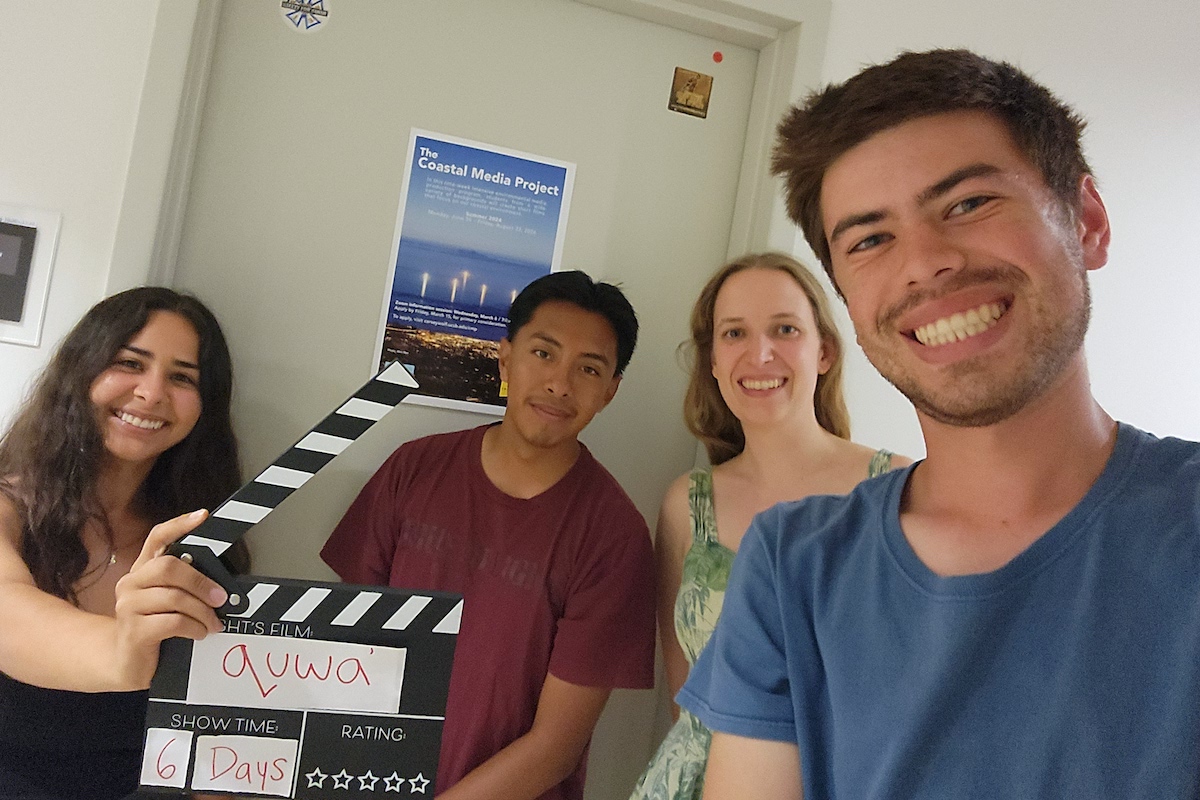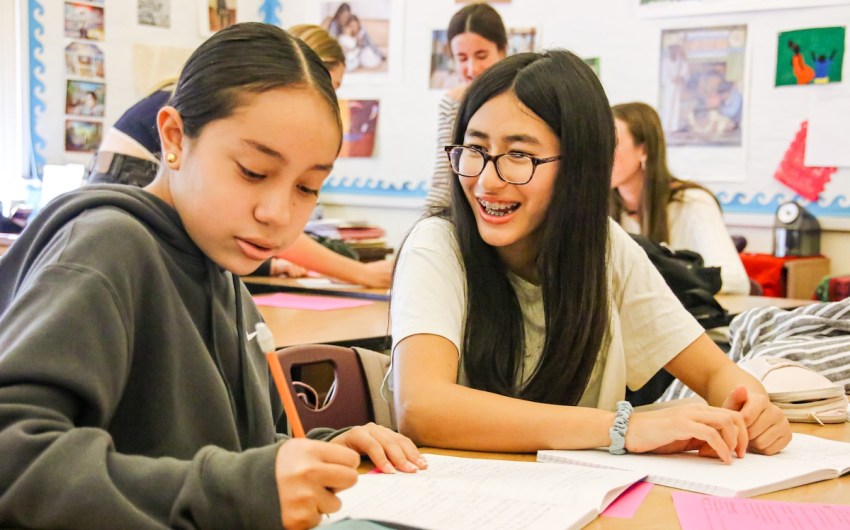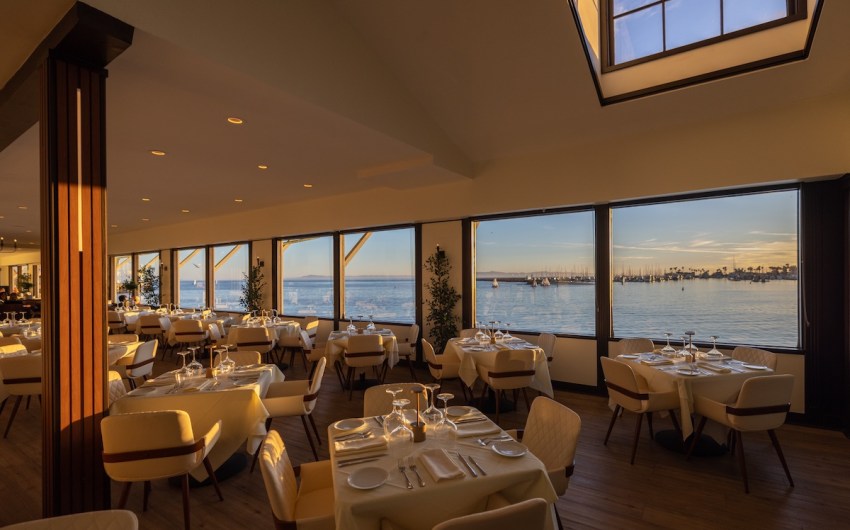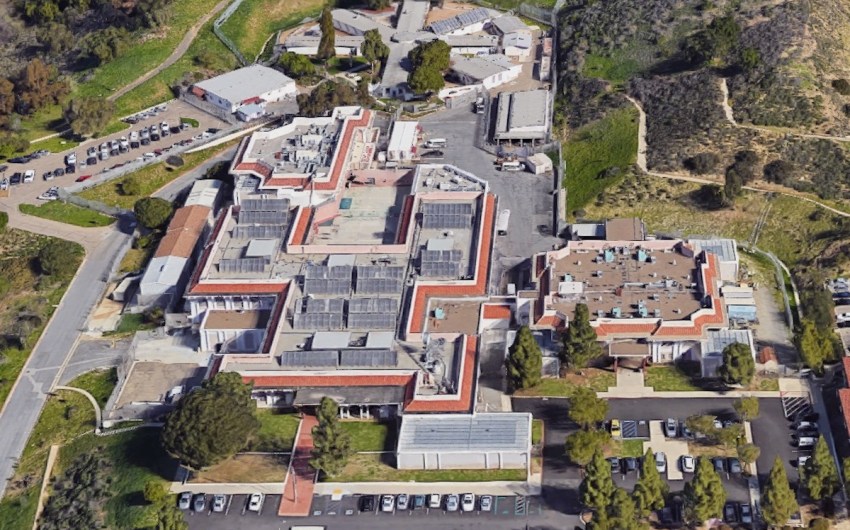Student-Made Documentary ‘Quwa’ Spotlights Little-Known Chapter of Santa Barbara History
'Quwa’ Features Chumash Voices and Ushers In Timely Conversations About the Land Back Movement

Beyond the black screen, the peaceful chirps of birds can softly be heard, complemented by a gentle rustling and the tranquil murmurs of running water. A light chanting is also just barely discernible and melds seamlessly with the soothing echoes of nature. Darkness melts away and the camera reveals a serene body of water, almost silver in color, lapping lightly against an empty shore. This scene is jarringly interrupted by a harsh screeching sound and the camera abruptly cuts to the source of the noise: a plane flanked by fumes, shooting into the sky.
This is the opening sequence of quwa’, a student-made documentary that premiered this summer at UC Santa Barbara’s Pollock Theater. The documentary was produced as part of the Coastal Media Project, a nine-week intensive media production program that has small teams of students work together to plan and execute an original documentary that focuses on issues related to the coastal environment.

Created by student filmmakers Jonathan Coronado, Ryan Grant, Jade Ipina, and Catherine Scanlon, quwa’ recounts the little-known history of the now-destroyed Chumash island, called quwa’ by the Chumash. The island occupied the Goleta Slough back when, prior to the area’s colonization, the slough was significantly larger, more resembling a bay. For at least 2,000 years, the island supported a considerable Chumash population. With numerous fresh water springs, a thick oak forest tree, and access to plentiful seafood and small game, two Chumash villages thrived on quwa’ before its inhabitants were eventually dispersed by Spanish colonizers.
Drawings and written accounts capture the blissful beauty of the island.
“We only get to think about it in our imaginations. We have no pictures of it, in all its glory,” said Marianne Parra, a Chumash interviewee, in quwa’. “But I read about the oak trees and I think ‘Oh my goodness.’ I instantly become very happy. But then I hear the planes. And I think ‘What would this look like without the planes.’”
The documentary chronicles the island’s steady decimation by ongoing colonization. What was once a magnificent hub of Chumash life has been literally bulldozed over the years. During the mid-1900s, quwa’ was unceremoniously dug up by construction crews. Excavating quwa’ provided the ample dirt that was used to fill the slough and create ground for runways and highways. This process also unearthed large amounts of Chumash remains and other artifacts, the majority of which were destroyed in the rush to complete what is now the Santa Barbara Airport. The island has been more or less reduced to a mound of dirt that is owned by the Southern California Gas Company and the Goleta Sanitary District, whose sewage treatment plant sits atop the ruins of the island. Beyond bringing attention to this neglected chapter of California history, quwa’ ushers in a timely conversation about solutions to the enduring displacement and eradication of culturally important Chumash land. The documentary integrates input from various Chumash voices, including Parra and Chumash elder Ernestine Ygnacio-De Soto, who discuss the Land Back movement and share their visions for how restitution can be achieved in Santa Barbara.

Coronado, Grant, Ipina, and Scanlon met with the Independent to explain the filmmaking process. When asked about their motivation to create a documentary about quwa’ and Land Back, Ipina responded that she “want[ed] to bring awareness to this sacred land that was taken and destroyed and to take this opportunity to open the conversation about land back and advocate for those voices that are not being heard.”
Scanlon revealed that, while many in Santa Barbara are unaware of this history, there is actually a wealth of accessible information online thanks to Tom Modugno and his website GoletaHistory.com. The group was able to use this site as a jumping off point for their research.
Each member was new to filmmaking at the start of the program, so the learning curve was incredibly steep. They all expressed that it was difficult to navigate the high-end equipment, allocate their budget, design the sound, and traverse the various other obstacles that accompany filmmaking, all the while working under a narrow time constraint. However, perhaps one of the biggest challenges was finding and incorporating Chumash voices. The group noted that this was not only a matter of getting in touch with the Chumash people, but also ensuring a respectful portrayal of participants and thoughtful presentation of the knowledge being provided.
“I was concerned that our Chumash participants would come off as, not just tokenized, but as a vessel of exposition, like they were just people providing information,” said Grant. “But I think that the way that we presented them and worked with them, they are very much characters in the film. They are individuals.”
“I think we’re really hoping that quwa’ can help to humanize the topic for people, that they can connect with Marianne and Ernestine as individuals as well as representatives of the Chumash people,” Scanlon added.
Parra talked more about her participation in quwa’. She mentioned that, during their lifetimes, her parents had staunchly advocated to protect the island and so being part of this project felt very natural for her. When asked how she envisions Land Back unfolding in Santa Barbara, Parra replied, “I’d love to actually be given a plot of land, enough space to set up a small cultural center. Everywhere we go [for our cultural classes] we have to get permission or ‘borrow’ somebody’s house. Spots are donated to us and it’s not always easy to have a straight schedule.”
She went on, “I’m not asking for a piece of land so that we can build a mansion on it. That’s not what we want. We’re talking about basic survival here.”
As explored in quwa’, Parra explained that these small demands have yet to be taken seriously. Rather, the Chumash continue to be forcibly displaced from their homeland. She pointed out that, currently, a Chumash elder is facing eviction to make way for a new boutique hotel. And this is just one story of many. Parra observed, “A lot of Chumash don’t even live on their homeland anymore because nobody can afford to live here.”
Parra stressed that, contrary to popular belief, colonial violence is far from “over.” In Santa Barbara and around the world we are still witnessing the brutal displacement of indigenous people from their ancestral lands. This is why the time for these conversations about decolonization and Land Back is now.
“It’s mind-boggling to me how people say ‘No, no, that was the past. We don’t do that anymore.’ But we see it happening in Palestine. We see it happening in the Congo. We see it happening all over,” Parra said. “My grandmother was born in 1916. She was a Chumash plant medicine woman. The things that she had been fighting for, I never could have imagined that, in 2024, would still be my same struggle.”

Echoing the sentiments that she shared in quwa’, Parra argued that, by avoiding uncomfortable discussions about how to move forward, these problems will remain unresolved and continue to linger potently for years. Candid, solution-oriented dialogue about indigenous well being is way overdue.
“If we’re just immediately gonna be scared and run away and not want to talk about anything because it’s ‘controversial,’ then these issues are just going to continue to get bigger. We don’t need to wait,” Parra said.
The documentary is a promising step in the direction of shedding light on these marginalized concerns and generating conversation.
“I was really, really grateful for them and their interest,” Parra reflected about quwa’. “I’m really hoping, for the general public and whoever sees [the film], that this is going to be that ‘a ha’ moment. That more people will think ‘What are we doing? Why have we been so blasé about everything? We need to stand up and take more of a stance!’”
Coronado, Grant, Ipina, and Scanlon plan to submit quwa’ to various film festivals, with the ultimate goal of spreading the word about this important story.
“Our hope is that more people are going to hear the message and maybe bring it back to other areas that are going through the same thing. Land Back isn’t just happening in Santa Barbara. It’s happening everywhere. We really wanted to open up this conversation about Land Back to a larger audience,” Ipina stated poignantly.
Premier Events
Thu, Nov 28
12:00 PM
Santa Barbara
Thanksgiving Dinner at The Harbor Restaurant
Fri, Nov 22
11:00 AM
Santa Barbara
Santa Barbara Antique & Vintage Show & Sale
Fri, Nov 22
6:00 PM
Santa Barbara
Introduction to Crochet Workshop
Fri, Nov 22
7:30 PM
Carpinteria
Rod Stewart VS. Rolling Stones Tribute Show
Fri, Nov 22
9:00 PM
Santa Barbara
Numbskull Presents: Jakob’s Castle
Sat, Nov 23
11:00 AM
Santa Barbara
Santa Barbara Antique & Vintage Show & Sale
Sat, Nov 23
12:00 PM
Santa Barbara
Fall 2024 Healing Arts Faire
Sat, Nov 23
7:30 PM
Santa Barbara
SBCC Theatre Arts Department presents “Mrs. Bob Cratchit’s Wild Christmas Binge”
Sun, Nov 24
11:00 AM
Santa Barbara
Santa Barbara Antique & Vintage Show & Sale
Sun, Nov 24
6:00 PM
Santa Barbara
¡Viva el Arte de Santa Bárbara! Mariachi Garibaldi de Jaime Cuellar
Sun, Dec 01
5:00 PM
Santa Barbara
Paseo Nuevo Tree Lighting Ceremony
Thu, Nov 28 12:00 PM
Santa Barbara
Thanksgiving Dinner at The Harbor Restaurant
Fri, Nov 22 11:00 AM
Santa Barbara
Santa Barbara Antique & Vintage Show & Sale
Fri, Nov 22 6:00 PM
Santa Barbara
Introduction to Crochet Workshop
Fri, Nov 22 7:30 PM
Carpinteria
Rod Stewart VS. Rolling Stones Tribute Show
Fri, Nov 22 9:00 PM
Santa Barbara
Numbskull Presents: Jakob’s Castle
Sat, Nov 23 11:00 AM
Santa Barbara
Santa Barbara Antique & Vintage Show & Sale
Sat, Nov 23 12:00 PM
Santa Barbara
Fall 2024 Healing Arts Faire
Sat, Nov 23 7:30 PM
Santa Barbara
SBCC Theatre Arts Department presents “Mrs. Bob Cratchit’s Wild Christmas Binge”
Sun, Nov 24 11:00 AM
Santa Barbara
Santa Barbara Antique & Vintage Show & Sale
Sun, Nov 24 6:00 PM
Santa Barbara
¡Viva el Arte de Santa Bárbara! Mariachi Garibaldi de Jaime Cuellar
Sun, Dec 01 5:00 PM
Santa Barbara

























You must be logged in to post a comment.